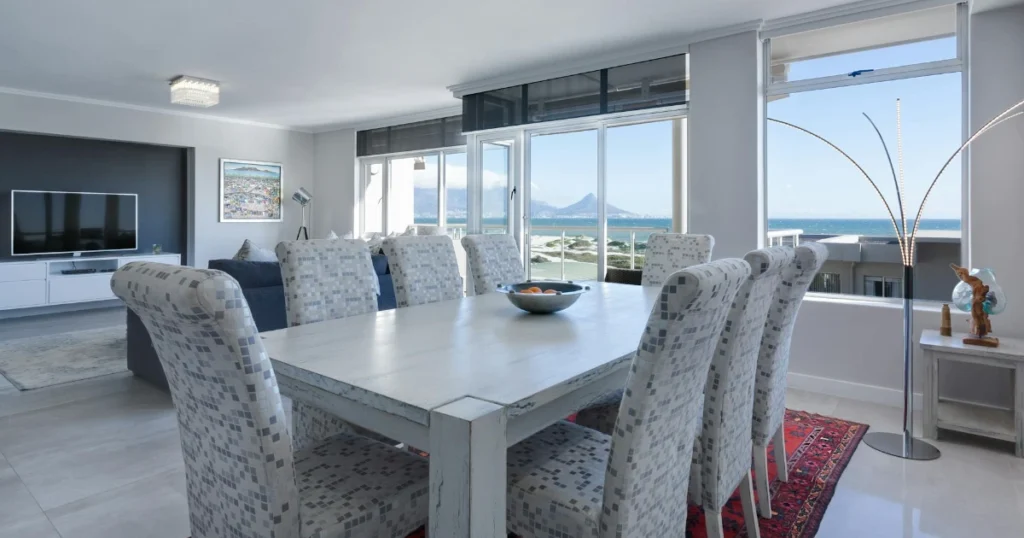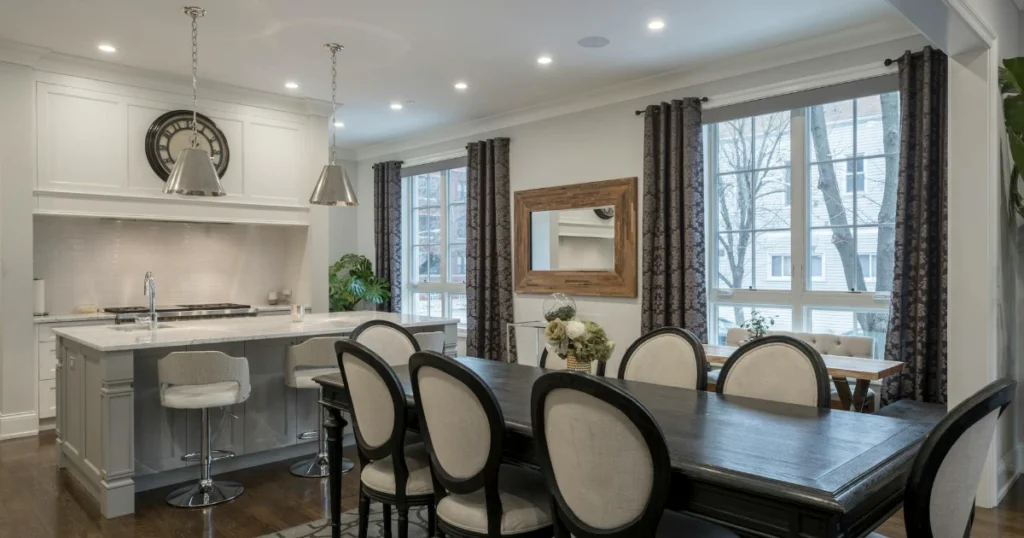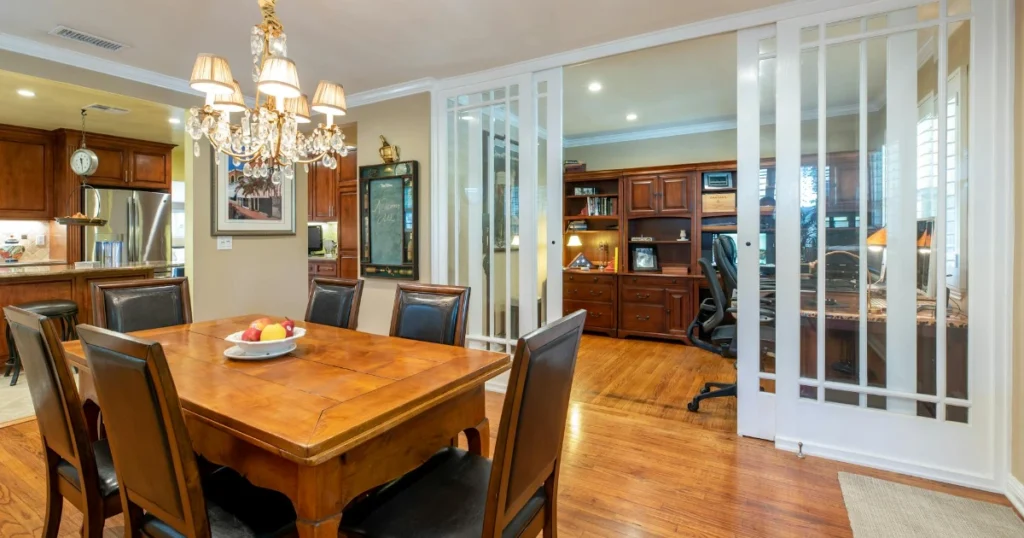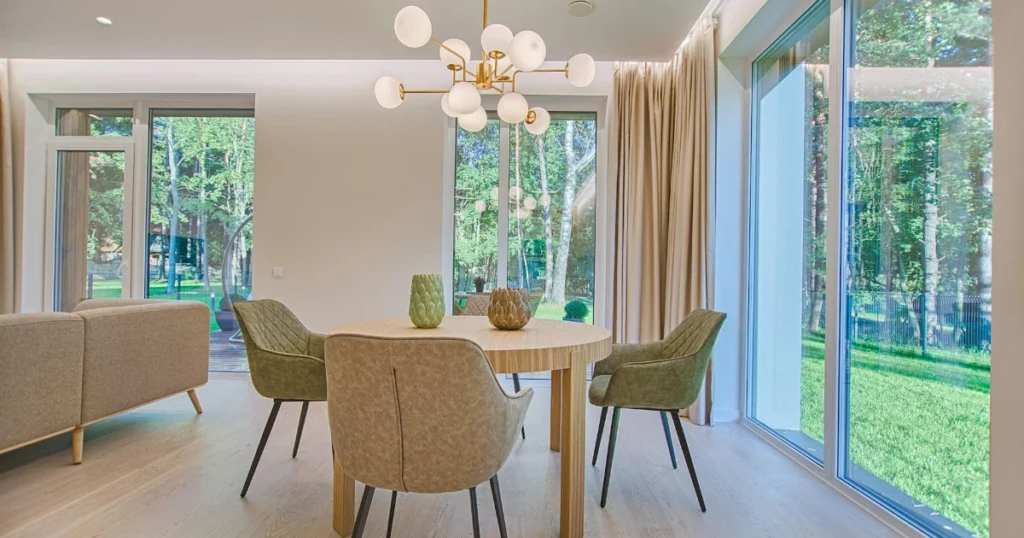Need to revamp your dining area? Discover five dining room ideas that will transform your space into a stylish and functional area with the right dining table, chairs, and lighting.
The Importance of a Well-Designed Dining Room
Next to the kitchen, the dining room gets a lot of usage. It is a gathering place for family meals. It can also serve as a makeshift home office, a homework spot for kids, or a place for family game nights.

Key Elements for Every Dining Room
Choosing the Right Dining Table
The first thing every dining room needs is a dining table. When starting with a blank slate, consider the size, material, and shape.
Size and Proportion
The size of the dining table should be proportional to the size of the room and your family’s needs. If you have a family of six, get a table with at least six seats. If you entertain often, a larger dining table might be the best option.
A good rule of thumb is to leave at least 36 to 42 inches away from all of the walls and passages. That would be the maximum size dining table you can get.
Shape Considerations
The shape of the dining table should reflect the shape of the room. In a square room, you can choose either a square table or a round table. If the room is longer than it is wide, opt for a rectangular table or an oval table.
If you want to get an irregular size shape, like an octagon or a live edge wood table, pay attention to the length and the width. Think about those things as you’re specifying the shape of the table in relation to the shape of the room.
Material Choices
Wood is a classic and solid option. There are many different types of woods out there. Options include solid wood, wood veneer, and distressed wood.
Wood is an easy choice because it comes in so many different stains and colors. Glass tables are very easy to maintain and bring a lot of light into the space. However, it’s not that kid-friendly since it’s very fragile.
A natural stone top is easy to clean, but natural stone is porous. It requires that you maintain and seal it. When sourcing the correct dining table material, think about your budget, family needs, and the level of maintenance.

Selecting the Perfect Dining Chairs
How many dining chairs you need in relation to the table is up to you and your family needs. Measure the length of the table in relation to how many people are seated on each side.
You typically need between 24 and 30 inches of seat space per person for everyone to be seated comfortably around the table. Measure every two feet on the length of the table and add two head chairs if it’s a rectangular or oval table. If you have a round table, the smallest size that you can get away with for four people is 36 to 42 inches.
Arms vs. No Arms
Consider when to specify a side chair (armless) versus a chair that actually has arms. Chairs with armrests are more comfortable, especially when seated at the dinner table all night. A meal can turn into after-dinner drinks, so you want guests to be as comfortable as possible.
Another detail to hone in on is ensuring that the arms slide neatly underneath the thickness of the table top. If it doesn’t, it’s going to take up so much room outside of the table. You need to factor that into the space that you have allotted.
Material and Maintenance
There are spills, stains, and all sorts of things that can happen during dinner, so get something that’s super easy to clean. Performance fabrics are great.
A designer velvet that is a poly velvet and cotton blend is easy to wipe off with a wet wipe or a wet cloth, and you can simply vacuum it right up. If you’re not committed to that level of maintenance, opt for something with a solid surface. It could be wood, metal, or acrylic. Think comfort and function.
Implementing Fabulous Lighting
Where the light fixture goes is conditional and depends on the height of your ceilings. Even with low ceilings, you can still manage to put a semi-flush mount over the dining table.
Look for overhead lighting, whether or not it’s task general or a fabulous statement chandelier, to lay right over the dining table center. If you have a longer table, you can offer two pendant lights or two flush mounts to distribute the amount of light evenly across the table. The goal is to look for something that makes a huge statement in the dining room because there are only so many components.

Placement and Height
A good rule of thumb is to always start at 36 inches above the dining table’s surface top. Depending on what the fixture looks like, you can go up from there. Too low, and you’re infringing on the surface tabletop. Too high, and you’re not lighting up the surface tabletop properly.
Statement Art or Grand Mirror
If you follow feng shui, you’ll know that feng shui loves a huge mirror in the dining room. The mirror doubles everything that it reflects in the dining table. It’s all about an abundance of richness for you and your family.
How large should that mirror be in the dining room? The bigger, the better. It should span at least two-thirds the size of the dining table. If you can’t find a mirror that large, you can opt for statement artwork. The proportions are really the same.
If your room is wide, you want to go for a wide piece of artwork. If the room is tall, you want to go for a tall vertical piece. If the room is small and petite, you just want to add a wow factor with some color and pattern.
Simple Centerpiece
Choose something very simple and chic. You don’t want to compete with all the other components that are happening in the dining space. Think about one simple vessel, or apply the rule of thirds. This means it’s a small cluster of three different items with varying heights and textures. Aim for something very simple and refined so it doesn’t compete with the rest of the space.
Essential Extras for Your Dining Room
These extras are conditional and based on the space that you have. If you have the space for it, a buffet, a sideboard, a console, or an extra storage unit is essential to the dining room.
Buffets, Sideboards, and Consoles
Shelves can house everything from bar wear to liquor to extra serving platters. Every single piece of furniture in the space needs to make up for storage.
Window Treatments
If you have windows in your dining room or a sliding door that leads to the patio or the backyard, window treatments are essential. Think about the amount of privacy and light that you need in the space.
Shades are a simple, modern, and effective way to let light in and control the amount of privacy. It leaves the outer walls for you to layer on softer drapery panels if that’s the look that you’re going for. The favorite type of treatments for sliding doors are sliding curtains or drapery panels.
Curtains and panels are easy to maneuver, especially when they’re on a traverse rod or if they’re installed with drapery rings. You can draw the curtains all the way back and move freely in and out of the space.

Area Rugs
Specify an area rug if you can fit the largest area rug you can in that space. You want to be able to pull your chair back away from the table and still land on the rug. The rule of thumb is 36 inches to 42 inches away from the edge of the table. The material should be easy to clean and a low pile.
Ambient Lighting
Ambient lighting casts a secondary glow to the space. It could be wall sconces that you install symmetrically outside of the mirror or the statement artwork. It could also be a floor lamp or a table lamp, especially if you have a buffet or a console. It just provides that extra glow, and everyone looks great in ambient lighting.
Unnecessary Extras to Avoid
Avoid tablecloths, table settings, glassware, china, huge candelabras, placemats, utensils, and napkin rings. Anything that you would set out for a formal dinner does not need to live on your dining table day to day.
If you love that look, more power to you. However, there is no need to take the time to dust and clean all of those extras on the dining table.